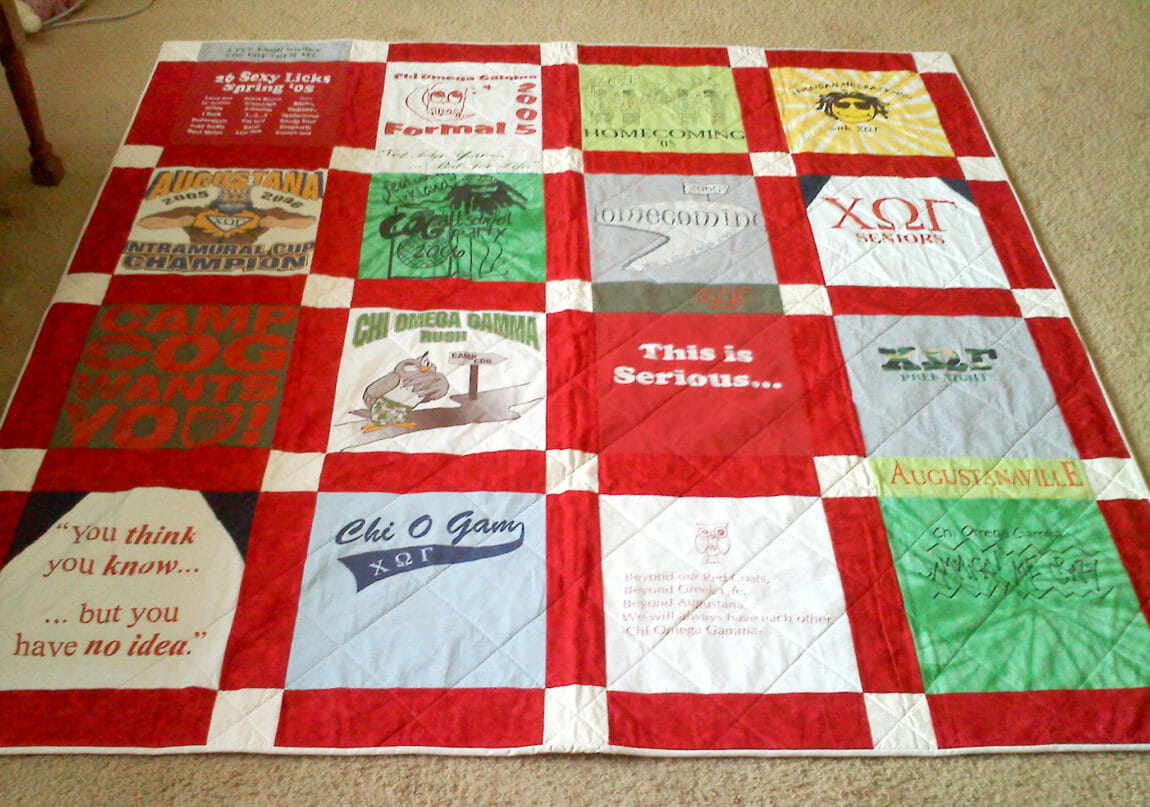
How to make a T-shirt quilt video tutorial
I’ve combined all the posts and instructions in the How to Make a T-shirt quilt series into one post. Now you can watch all 10 videos, get your fabric requirements and sashing chart all in one location.
Pin this page, bookmark it, share it on Facebook, do whatever you have to do to remember the web address so you can come back to see how to do the next step as you make your T-shirt quilt.
Fabric requirements
Cutting the T-shirts
Attaching the fusible interfacing
Sewing the sashing
Laying out the quilt blocks
Putting the blocks together
Marking and basting the quilt
Quilting
Binding
(Visited 4,015 times, 2 visits today)
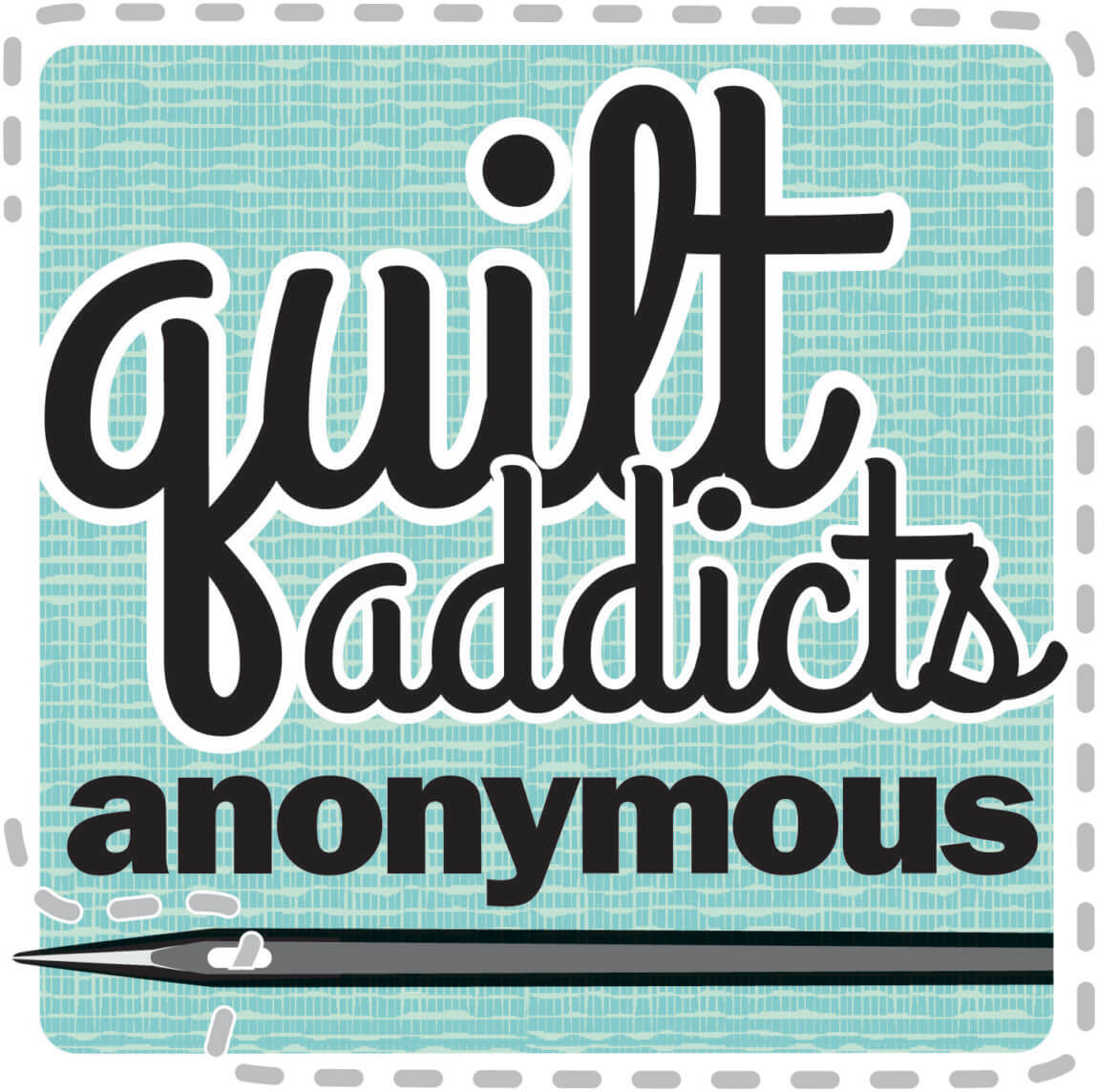

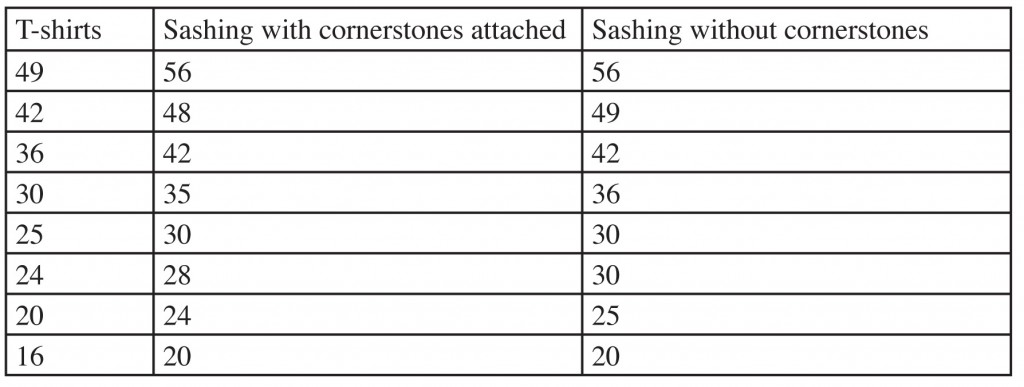
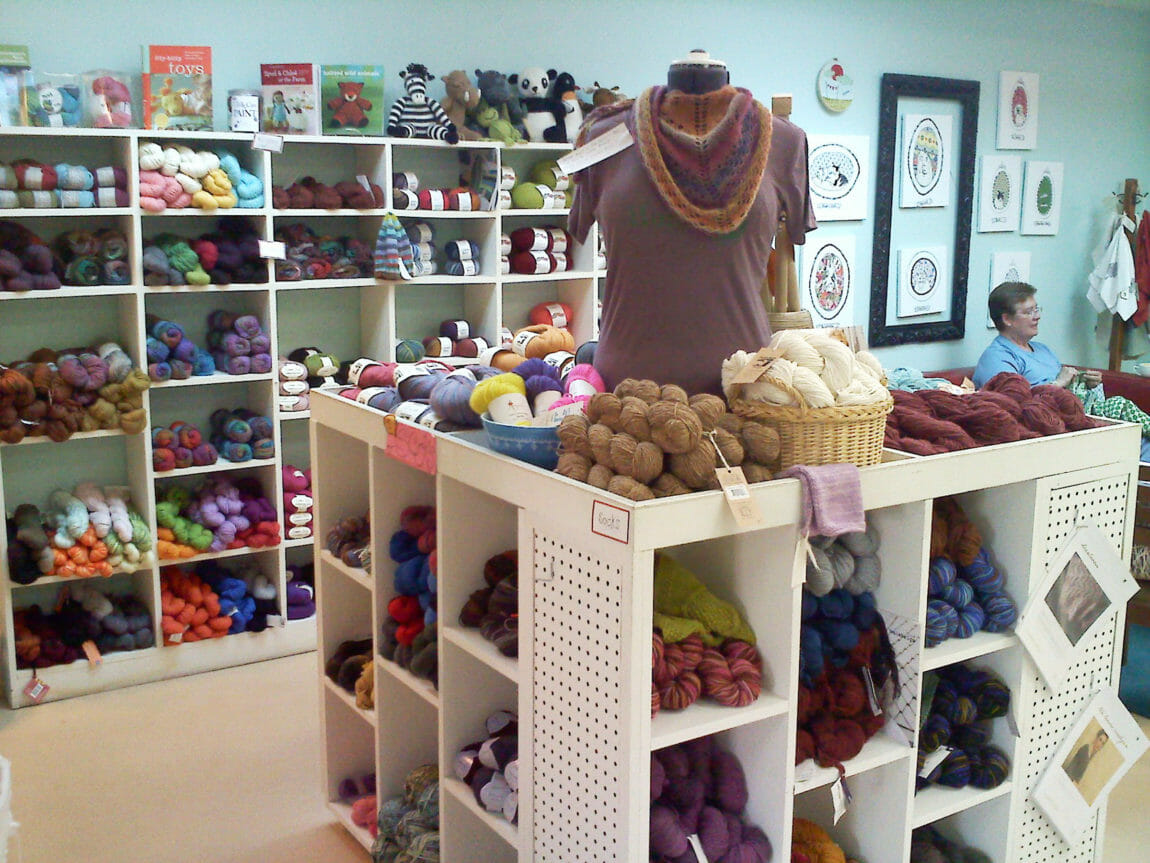
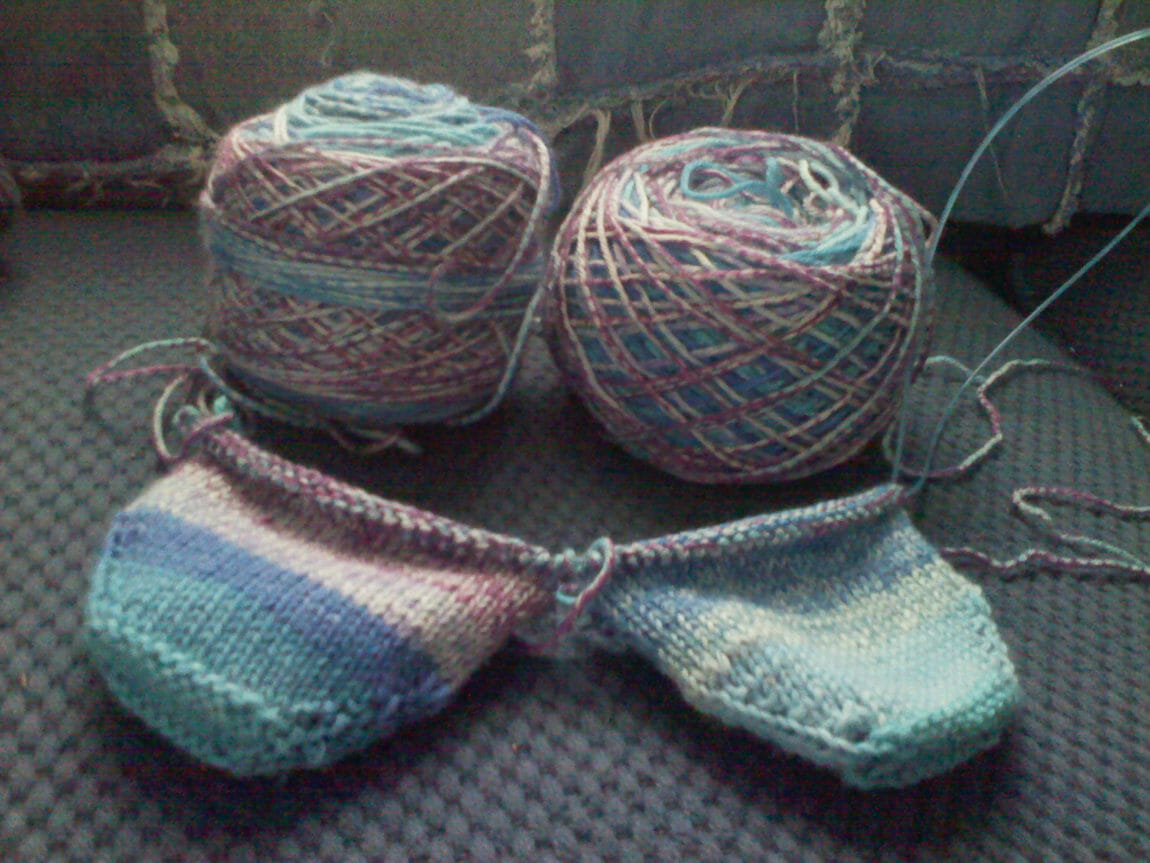
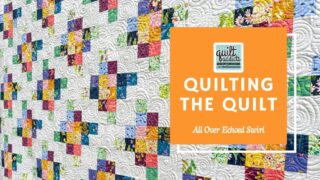
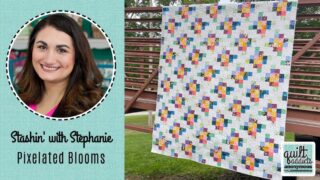
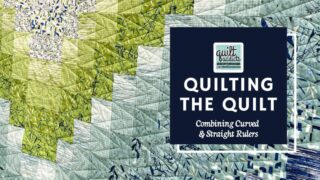
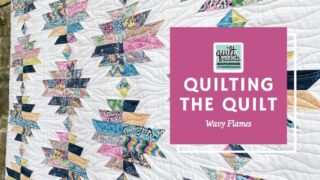
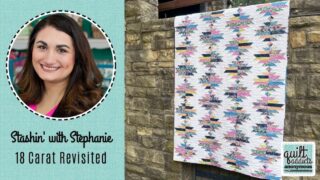
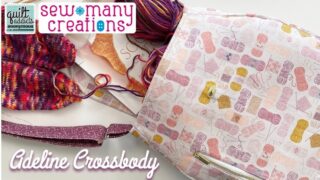
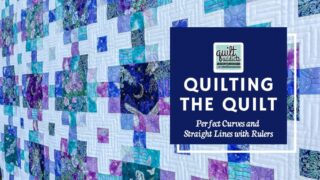
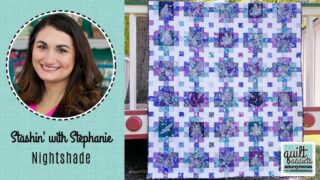
The binding is the only part that confuses me… How can I flip it over to sew it onto the back of the quilt if I’ve already sewed it to the front of the quilt? In other words, if you fold it in half and stitch it to the front of the quilt, isn’t it sewn folded together and therefore there isn’t any excess to fold/sew onto the back?
If you cut your binding to 2 1/2 inches wide by the width of fabric, then you’ll have just enough to flip over to the back side to enclose the raw edges of the quilt.
Is there a magic number to add on to the sashing if I don’t want to do cornerstones? I am making my husband a quilt from his Fire Dept shirts, and he wants all the sashing to be the same color/design. Also, I am making larger squares as his print on the back is bigger. My squares are 16″, and I am using 20 shirts. I am a sewer, not a quilter, so this is foreign territory to me!
I am hoping to sew all the sashing and shirts together to make the top piece, and then take it to someone who can do the actual quilting for me.
Since you’re a sewer, then you already know the importance of seam allowances, so as long as you get the 1/4 seam allowance in quilting down, you’ll do fine. I’m making the assumption that your squares are 16 inches finished (meaning after you sew them together and loose half an inch due to seam allowances) If that’s not correct, then subtract .5 inches from the lengthwise measurements to get your sashing strip dimensions.
Side sashing: Cut to 3 x 16.5 inches (which will finish 2.5 x 16 inches once you factor in seam allowances)
Top sashing: Cut to 3 x 19 (which will finish 2.5 x 18.5 once you factor in seam allowances)
Also, the fabric requirements I gave you won’t be enough for these measurements. I’d buy at least a yard extra so you don’t run out.
Thank you so much! I already made my first mistake..eek I had intended for my finished square to be 16″, but I forgot to account for my seams. Darn. This is for my husband though, and he will never even know there was a change in my plans. 🙂
I greatly appreciate your help and these wonderful tutorials!
Nobody will ever notice a “mistake” like that unless you tell them. 🙂 Just tell everyone it was intentional.
I’m told such things may also be called “Design Decisions!” LOL As a old sewing gal / new quilter, I make many Design Decisions!!! I just had to reply to this even though it is an old posting. —Anita
I’ve completed the steps to the point where I have my blocks arranged how I want them (24) and am ready to sew them together, but for the life of me I can’t figure out how to arrange the remaining sashing strips. The four corners of the quilt have a cornerstone, right? It seems like all the sashing to be sewn on the right side and bottom blocks need to have a cornerstone attached. And in fact, it seems like one corner block would need a sashing with two cornerstones. But the instructions say I should be placing 4 more sashings with cornerstones and 6 without. Help! I can’t figure out this puzzle. (Sorry, I’m a novice.)
You want to attach the sashing and cornerstones to the same two sides of every block. For example, you can attach the sashing piece to the left side of all the blocks and the sashing with the cornerstone attached to the top of all the blocks. Then when you lay the quilt out, there will already be sashing strips in between each block.
Once you have determined your layout, that is when you sew additional sashing and cornerstone pieces to the blocks on edge of your quilt. In this example, you would sew them to the blocks on the far right and bottom rows. I’m a visual learner, so I’m attaching an image that hopefully will help this explanation make sense.

I’m having the same problem. The bottom and along the right side looks like I use all cornerstones but the bottom right will not end up with one. Your tutorial doesn’t show how to attach the bottom and right side. Can you post this or explain. Currently, my sashing runs along the top of square and the cornerstone along the left side. I have 4 squares going across in 5 rows. I can’t figure this out. Someone please help!! Thanks
Kathy W
I know this is a super delayed response, but you ladies are right. You only need sashing without cornerstones in the interior. Once all blocks are arranged the remaining two sides of the quilt all need sashing with cornerstones and the corner piece needs sashing with two cornerstones attached. I’m making a 5×5 quilt from 25 shirts. The chart said I needed 30 strips of sashing with cornerstones and 30 without. I actually need 25 without, 34 with, and 1 with 2 cornerstones.
I have never sewn anything before, but I watched your videos about ten times and I made a perfect tshirt quilt for my son and I am so proud of myself! Thank you for the step by step for us novice moms. The quilt ended up so awesome that now my husband wants me to make one from his fire department tshirts. The issue I am having is that these tshirts are larger and the design areas to be cut are about 13″ x 13″. Any suggestions on how to accomplish this? I have searched and I cannot find a ruler with the dimensions I would need, and 15″ x 15″ is just too big (there is not enough shirt before the seems at the neck and sides), while the 12.5″ square ruler would cut off people’s names. I can’t even piece the blocks together to make them 12″ square. I am sure I could figure out how to resize everything around a 13.5 square if I could figure out an easy way to cut them (and the interfacing).
I would get a 15-inch ruler and put painter’s tape at the 13.5 inch mark. Then you’ll have a clear visual of where you need to cut. You will need to lift up the ruler in order to reposition it, but as long as you don’t move the T-shirt, it should be OK.
Stephanie,
I can’t thank you enough for the t-shirt quilt tutorials! I don’t know how many times I’ve watched them. This is my 1st sewing project ever, so I’m estatic that I’m almost to the actual quilting step, but very nervous I will mess it up because it all looks so great right now. I have a couple of questions. My quilt is with 30 squares. Could I actually utilize a flat bed sheet as my backing? JoAnns doesn’t have much of a selection in fabrics that are wide enough, but I guess I could stitch 2 pieces down the middle. Just thought a bed sheet might work. Also, I’m confused on where to mark the additional chalk lines in the tutorial. I know you do corner to corner so it’s like a big X through each square, but how do I measure other lines and is it necessary to do more lines? I did buy the warm and natural batting, so I think you mentioned that it would be alright with lines that far apart. What is your advice? Thanks a bunch!!
You don’t want to use a bed sheet as backing fabric, because the thread count is different and you may end up with tiny holes that don’t close when you wash it. Check out your local quilt shop for backing fabric.
I am beginning a t-shirt quilt for my daughter. I would like to incorporate some of her dance costumes in this quilt. What are you thoughts on that? Most of the material is shiny and stretchy. I was thinking if I couldn’t use the material for full squares, maybe for the sashing strips or cornerstones. Does this type of material have to be stabilized as well?
thanks for you thoughts!
Brenda – My main concern would be the fabric melting under the heat of the iron. I would test a few swatches that you can spare before cutting everything up to see how it behaves. You may have to adjust your iron to a lower heat setting for nylon. Otherwise, once you successfully fuse the interfacing to the material, you should have no problem quilting as normal.
Thanks! do you think it matters what type of fusible interfacing I use?
Use a lightweight woven fusible interfacing. I prefer Pellon. They make a version that is 44 inches wide and feels like cotton fabric on the back.
How big did you make the cornstones? Before you cut them into 3 inch strips.
Cut a 3″ by width of fabric strip for the cornerstones.
I have just finished the front of the quilt and would like to add a simple border. Do you think the border should cut to 3″ like the sashing and cornerstone or do you think something wider would look better? I am thinking a little wider. I didn’t know if there was a guide to go by or if you just do what you like. Haha! Thanks for you help!
I like to have my borders be twice the width of the sashing. The sashing finishes 2.5 inches wide, so to have a border that finishes 5 inches wide, you’d have to cut it to 5.5 inches wide.
I am getting ready to attempt my first tshirt quilt! I have watched the videos over and over and over! Any pointers before I begin??
Just make sure you take your time measuring and sewing your quarter inch seam. If you do both of those tasks accurately, you’ll have no trouble putting the quilt together.
I’m confused about the length of the cornerstone fabric that attaches to the sashing…I’ve watched video #3 several times and didn’t see it! I’m sure I’ve overlooked it but the more I look the more confused I get! How long should the cornerstone pieces be?? Is it 3″ x the width of the fabric?
Thanks!
Yes, it is 3 inches by the width of fabric.
Single, queen or king how many squares for each are required? Not listed on yourwebsite thanks
It is listed in the chart at the top of this page. The number of T-shirts is the number of blocks.
I notice you don’t backstitch when sewing the sashing. Don’t you worry the seams will come apart after being washed several times? This quilt is for my granddaughter to take to collage and I’m sure it will be very used. So glad I found this web site !
You never have to back stitch when quilting. That’s because you cross seams so many times during the construction process, and that secures the seams.
I’m sorry for so many questions but this is my first project and I’m not sure what I’m doing. Can I use cotton flannel fabric for the back.
Of course! I love using flannel on the back of my quilts.
I have been putting this off for a year now. I have cut out the t shirts and attached to the interfacing. I’m kind of nervous about the next step. I have cut up my husband’s motocross shirts. My problem is they are not all the same size. Some of the print are on the whole shirt. I also have some shirts where he had the professional racers signatures on them. I do not want to cut them off. What do you suggest. Help. I am not a sewer. But this is something that I would really like to do.
When I teach this class in person I instruct the students to keep in what is most important to them when the design is larger than the 12 1/2″ square. For you you that would be the signatures. I wouldn’t worry too much about shirts where the design doesn’t take up the whole square, it helps tone the quilt down and keep it from looking too busy. There are other patterns where you cut the T-shirts to fit the design and figure out how to fit them all together later, but they are more advanced. You can do a Google search to find an example.
Stephanie ,
I have watched your T-shirt tutorials numerous times to help me in making a t-shirt quilt . I have my quilt sandwich already to sew . The problem I’m having is that the Sulky Premier invisible thread keeps breaking while sewing . At the rate this is going I’ll never get this quilt finished on time . Any help and advice you can give me on this matter would be greatly appreciated , as to what I can do to correct this problem . After the sewing machine needed is threaded , is there a certain part of the walking foot where the thread needs to go ??
Thank you ,
Ruthann
Ruthann:
You need a heavier-weight thread.
I’m making a t shirt quilt for my son. The fabric I have for the sashing has the college name. So, there is a definite direction to the fabric. It is 100% cotton but there is more give one way than another. Do I need to worry about that? Also, when I cut the strips I’ll have to cut in the opposite direction to maintain the direction of the words. I’m a newbie so any suggestions would be great! Love your videos.
A good way to keep fabric from stretching is to spray starch the heck out of it prior to sewing. The starch helps the fabric keep its shape during the construction process. Otherwise just be very careful when cutting and pinning and you’ll be OK. Good luck!
Hey Stephanie,
I watched your entire t-shirt quilt tutorial so I could make one for my daughter. You explained everything really well! So, I have interfaced all the 49 (12″)squares and now I am on the step of sewing on the sashing and have completed almost half of them. I am now worried though because I did not pre-wash the sashing fabric and am wondering if I should have. I think the fabric is 100% cotton. It was just standard quilting fabric I got at a local fabric store. Do you think it is going to turn out ok?
thanks, Peggy
Pre-washing is really a matter of preference in most cases. Unless you’re dealing with a fabric that could have excess dye (batiks, black, dark blue and red) you’re probably safe. If your fabric does have any of those colors in it, or you just want to be careful, pick up a box of Shout Color Catchers, and throw a few sheets in with your quilt when you wash it for the first time.
I watched your videos several times but I am not sure on what size the corner stone should be and the length of each sashing can you explain thanks
The cornerstones finish 2.5″ square and the sashing finishes 2.5″ x 12″
I’ve never used a rotary cutter before, so in addition to cutting myself several times I learned on the acrylic square too much and some of my t-shirt squares are not cut perfecly. Am I going to be able to get away with this? I only have 15 shirts so i need to use all the ones I’ve already cut. All this is foreign out-of-the-box work for me and I’m totally dependent on the tutorial.
Thanks.
Ouch! Fons and Porter makes a cutting glove that is supposed to prevent injuries. As long as you get the hang of it and cut the interfacing to the right size you’ll be fine. You just may have to do some stretching when you fuse the T-shirts to the interfacing. 🙂
Hi Stephanie ,
I have watched your t-shirt quilt making video many times and have completed my first t-shirt quilt . I am in the process of making another , but one of the things I have found both times is that the sulky premier invisible thread kept breaking while doing the quilting part ,even after putting the spool of thread in a glass to relax it . Can I use a different kind of thread such as 100% cotton ? Any advice you can give me would be greatly appreciated .
Thank you ,
Ruthann
You can use 100 percent cotton thread if you want. Just choose one that blends well with the fabrics in your T-shirt so the focus will be the designs of the shirts, not the quilting.
Gutterman makes a heavier-weight invisible thread that will not break like the sulky does.
How do I know how much backing I need for a 40 square t shirt quilt? Do you buy one huge piece of backing? Or piece several 45″ wide together? And what type of fabric do you use?
Thank you
Your backing fabric needs to be 10 inches wider than your quilt. So for a 40 inch square quilt, you’ll want backing fabric that is 50 inches square. If you buy two lengths of 45 inch wide fabric you’ll have a lot of leftover fabric. You’ll have less waste if you get two yards and piece the backing together.
I have about 16 squares different sizes, how much fabric do yo think I need???? The video is nice and easy to follow however, I am watching it in a small samsung tablet, inorder to have it in the sewing room, any suggestions???
It is not possible to determine how much fabric you need unless I know the sizes of the squares. You also probably will not be able to use this pattern if your squares are different sizes. There are T-shirt quilt patterns out there that feature different sized T-shirts. I suggest doing a Google search to find one.
Why do you sew the strips of binding together to make an angle rather than straight across? If I were to add a border around my T-shirts, should I sew those strips together in the same angled fashion? Should I be cutting strips for binding out of regular fabric? I’m still in the gathering materials stage, but I’m trying to fully understand the process before diving in and destroying my t-shirts! The details of your videos are perfect for first-timers. Thanks so much!
You sew the binding strips together at an angle so there is less stress on the fabric. The binding is one of the most used and abused parts of a quilt, so sewing them together at an angle helps it last longer. As for the border, some people sew them together at an angle, others just piece the rectangles together. It’s a matter of personal preference. As for the fabric, you’ll want 100 percent cotton quilting fabric for this entire project. I highly recommend purchasing it at a quilt store. The prices are a little higher than the big box stores, but the quality is much better as well and will make for a better experience when sewing your first quilt.
Thank you for this tutorial! It was very easy to follow along. I just finished my first t-shirt quilt for a dear friend’s retirement. Thank you again!
Thanks so much for the step by step instructions! Is there anyone who can use the left-over t-shirt material? It seems like such a waste.
You can use it as dust rags.
+About the left over backing of the tshirts, I seen a video on you tube, DIY, and they used their backing as an added square to their blanket, so it was broken up. It was really pretty. I am getting ready to do several blankets for a lady and her 2 children. Her husband and the children’s father died so I hope I don’t mess this up. I am a pretty crafty lady so hopefully I will get this right. I also seen your measurements for how many 12 inch
blocks but I am not sure the sizes of a king, queen, full, or twin blankets are, so I am confused. could you please break it down for me. My email is delma35 if you could send me those breakdowns I would appreciate it.
Thank you for having a great tutorial.
Della
Dear Stephanie, thank you for this complete collection on making a t-shirt quilt located here and in youtube.com. I have been working on this holiday present with your guidance. You are a natural mentor teacher! Thank you for sharing you talents in videos, data charts, personal comments and pictures!
Hello, Thanks so much for this video! I appreciate the time it took to post it. I am new to sewing and don’t have a lot of time to put my t-shirt quilt together (2wks) I have all t-shirts cut and don’t have interfacing ironed on(yes, I should’ve ironed first). I am confused about the sashing. I have a few shirts that aren’t like the rest most are 12.5×12.5 and others are larger, some smaller. I’ve seen quilts that have sashing for fill-in. Any suggestions appreciated
The pattern is designed so that everything will go together and be square. There certainly are other patterns that use different size T-shirts but since you are new to sewing, I definitely recommend that you find a pattern you like and follow it exactly in order to have the best results.
Great tutorial. Thanks! Questions: 1.What weight Pellon would you recommend? 2. What is the name of the marking pencil/chalk that you used? 3. Did you used curved quilter’s safety pins or just regular safety pins for basting? 4. When you put the Sulky invisible thread in a glass jar is there anything you need to hold the thread in the jar? Thank you for all your help.
I am watching your tutorial & am learning a lot when I came to the “how to lay out the blocks” & it’s not that but “how to sew the binding through the whole quilt” & every video after that is the same!! I do not have how to lay the blocks out, how to do the batting or the backing!!! Can you help me find those tutorials? I am helping my granddaughter (who is leaving for college on 8/20) make a t-shirt quilt…thanks for your help!
Now I just went back over the web page & all of the videos are there!! Thanks anyway…I will watch them…don’t know where they went!!
Hi there! I am having trouble finding wide back solid black fabric for my backing. I live near Chicago. Do you know any online or quilt shops that have a variety of options I can use? I don’t really want to use two pieces of fabric for the backing… Help!
*My quilt top is about 89″ square, so I would need 99″ square of backing fabric
Hi Stephanie! I have extra t-shirts left over from my quilt project. Do you have a pattern for making a t-shirt quilt pillow? I have never made a pillow before and thought it would be cute. Thanks!
I bought 22″ fusible interfacing, my blocks are 12 1/2″ squares, so I have interfacing pieces left over from each block. Is there any way I can use these pieces on a block?
Help me Stephanie, I finished watching part 1&2 and am up to part 3 of your tshirt quilt tutorial. I do not know how long to cut the cornerstone squares and the sashing lengths. Did I miss something? I cannot find those details. Your descriptions so far have been so helpful. Please advise. THANKS
I just finished making my first t-shirt quilt from my old t-shirts and am now beginning one using my husband’s old t-shirts. Thanks for taking the time to make the videos, Stephanie. I would never have attempted this project without your guidance (and the encouragement of a friend who has made 2 t-shirt quilts using your tutorial).
Love this blog
I would like to see the instructions for the steps in the How to Make a T-shirt quilt post. I can only see the grids for the Fabric requirements and Sashing quantities. I want to share this with a friend.
OH NO!!! WHERE ARE THE VIDEOS??? My friend made a t-shirt quilt using your videos waaaaay back in 2011. I’m ready to make one of my own now. I have had this site bookmarked for LITERALLY OVER A DECADE but the videos are gone???
Well, it appears I panicked over nothing. 🙂 I searched your site and found the videos. Thank you for keeping them all these years!